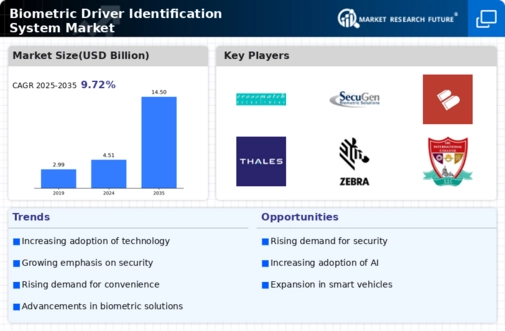Market Growth Projections
The Global Biometric Driver Identification System Market Industry is projected to experience robust growth over the coming years. The market is expected to reach 4.51 USD Billion in 2024, with a remarkable CAGR of 11.2% anticipated from 2025 to 2035. By 2035, the market could potentially expand to 14.5 USD Billion, reflecting the increasing adoption of biometric technologies across various sectors. This growth trajectory indicates a strong demand for secure and efficient identification systems, driven by technological advancements, regulatory support, and heightened awareness of security concerns.
Government Initiatives and Regulations
Government initiatives and regulations play a pivotal role in shaping the Global Biometric Driver Identification System Market Industry. Many countries are implementing stringent regulations aimed at improving road safety and reducing accidents caused by unqualified drivers. For instance, the introduction of mandatory biometric identification for commercial drivers is gaining traction in several regions. These regulatory measures not only promote the adoption of biometric systems but also create a conducive environment for market growth. As governments continue to prioritize safety and security, the demand for biometric driver identification systems is likely to increase, further propelling the market.
Increasing Demand for Enhanced Security
The Global Biometric Driver Identification System Market Industry experiences a surge in demand for enhanced security measures across various sectors. As vehicle theft and unauthorized access to vehicles remain prevalent issues, biometric systems offer a robust solution by ensuring that only authorized drivers can operate a vehicle. This heightened focus on security is reflected in the projected market growth, with the industry expected to reach 4.51 USD Billion in 2024. Governments and organizations are increasingly adopting biometric technologies to safeguard assets and improve safety, thereby driving the market forward.
Integration with Smart Vehicle Technologies
The integration of biometric driver identification systems with smart vehicle technologies is transforming the Global Biometric Driver Identification System Market Industry. As vehicles become increasingly connected and automated, the need for secure and efficient driver identification systems becomes paramount. Biometric systems can seamlessly integrate with advanced driver-assistance systems (ADAS) and vehicle-to-everything (V2X) communication, enhancing overall vehicle security and functionality. This integration not only improves user experience but also fosters the development of innovative applications in the automotive sector. As the market evolves, the synergy between biometric technologies and smart vehicle systems is expected to drive significant growth.
Growing Awareness of Identity Theft and Fraud
The rising awareness of identity theft and fraud significantly impacts the Global Biometric Driver Identification System Market Industry. As incidents of identity-related crimes escalate, both consumers and organizations are seeking more secure methods of identification. Biometric systems provide a reliable solution by ensuring that only verified individuals can access vehicles, thereby reducing the risk of fraud. This growing concern is driving the adoption of biometric technologies in various sectors, including transportation and logistics. Consequently, the market is poised for substantial growth, as stakeholders recognize the importance of implementing robust identification systems to safeguard against potential threats.
Technological Advancements in Biometric Systems
Rapid technological advancements in biometric systems significantly influence the Global Biometric Driver Identification System Market Industry. Innovations such as facial recognition, fingerprint scanning, and iris recognition are becoming more sophisticated and reliable, enhancing user experience and security. These advancements not only improve the accuracy of identification but also reduce the time required for authentication. As a result, the market is anticipated to grow at a CAGR of 11.2% from 2025 to 2035, potentially reaching 14.5 USD Billion by 2035. This growth is indicative of the increasing integration of biometric technologies in various applications, including automotive and transportation sectors.

















Leave a Comment